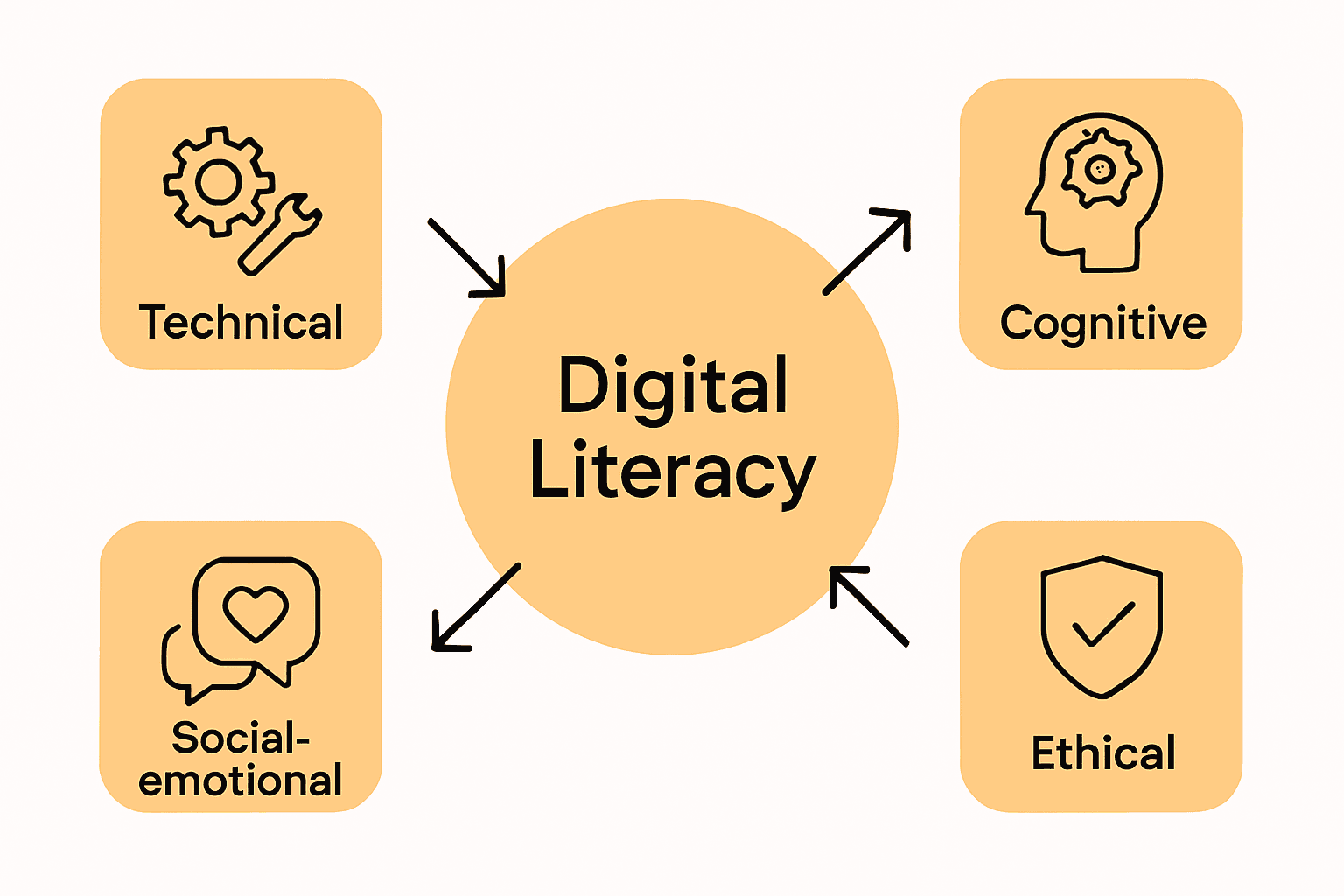Over 80 percent of organizations cite digital skills gaps as a barrier to growth. As technology transforms how companies connect, collaborate, and compete, digital literacy moves to the front of business priorities. Understanding its meaning and impact can help leaders build teams who thrive on any digital platform and adapt quickly to new workplace demands.
Table of Contents
- Defining Digital Literacy In Business Contexts
- Key Dimensions Of Digital Literacy Skills
- Integrating Digital Literacy With Adobe Workflows
- Common Risks And Barriers To Adoption
- Strategies To Enhance Enterprise Digital Literacy
Key Takeaways
| Point | Details |
|---|---|
| Importance of Digital Literacy | Digital literacy is essential for businesses to ensure operational efficiency and innovation in a rapidly evolving technological landscape. |
| Core Competencies | Organizations must focus on developing skills in technical, cognitive, social-emotional, and ethical dimensions of digital literacy. |
| Training Strategies | Continuous training initiatives, personalized learning pathways, and mentorship programs are vital for enhancing digital skills among employees. |
| Addressing Barriers | Enterprises need to tackle organizational resistance and financial constraints to effectively implement digital literacy strategies. |
Defining Digital Literacy in Business Contexts
In today’s rapidly evolving technological landscape, digital literacy has become far more than just understanding basic computer skills. According to Wikipedia, digital literacy encompasses the ability to understand and effectively communicate across multiple platforms and media formats. For businesses, this means developing comprehensive capabilities that extend well beyond traditional workplace competencies.
Transliteracy represents a critical component of modern digital literacy. As defined by Wikipedia, it involves the capacity to read, write, and interact across diverse technological platforms – from traditional communication methods to advanced digital networks. This skill is particularly crucial for enterprises seeking to maintain competitive advantage in a continuously shifting technological environment.
Digital literacy in business contexts involves several core competencies:
- Understanding diverse digital communication platforms
- Effectively navigating digital collaboration tools
- Adapting quickly to new technological interfaces
- Analyzing and interpreting digital information strategically
- Maintaining robust cybersecurity awareness
For enterprises, digital literacy is no longer optional. It represents a fundamental requirement for operational efficiency, innovation, and sustained growth. Organizations must invest in continuous training programs that help employees develop sophisticated digital skills that transcend basic technological proficiency. Comprehensive digital transformation guides can provide valuable insights into building a digitally fluent workforce.
Key Dimensions of Digital Literacy Skills
Digital literacy is a multifaceted concept that extends far beyond simple technological competence. According to research from MDPI, digital literacy encompasses four critical dimensions: technical, cognitive, social-emotional, and ethical aspects. This comprehensive framework provides enterprises with a holistic approach to understanding and developing digital skills in their workforce.
The technical dimension represents the foundational operational abilities required to effectively use digital tools and technologies. As highlighted by ERIC, this includes proficiency in navigating digital interfaces, understanding basic software functionality, and maintaining technological equipment. For businesses, this means ensuring employees can confidently utilize various digital platforms and adapt to emerging technological tools.
Key dimensions of digital literacy skills include:
Here’s a comparison of the four key dimensions of digital literacy skills for enterprises:
| Dimension | Core Focus | Typical Skills |
|---|---|---|
| Technical | Operational proficiency | Navigating interfaces Software use Equipment maintenance |
| Cognitive | Problem-solving & critical thinking | Information analysis Logical reasoning Strategic decision-making |
| Social-Emotional | Communication & collaboration | Digital etiquette Teamwork Conflict resolution |
| Ethical | Responsible technology use | Data privacy Cybersecurity awareness Ethical judgment |
- Technical Skills: Operational proficiency with digital tools
- Cognitive Capabilities: Advanced problem-solving and critical thinking
- Social-Emotional Competencies: Effective digital communication and collaboration
- Ethical Awareness: Responsible and mindful technology usage
Beyond technical skills, the cognitive and social-emotional dimensions are equally crucial. These involve developing high-level problem-solving capabilities, critical thinking, and the ability to communicate effectively across digital platforms. Organizations can enhance these skills through targeted training programs and digital literacy essentials guides that focus on comprehensive skill development.

Integrating Digital Literacy With Adobe Workflows
Digital literacy is no longer optional for modern enterprises, especially when working with complex software ecosystems like Adobe. According to Wikipedia, digital scholarship involves leveraging digital methods of inquiry, research, and content creation to achieve organizational goals. This approach becomes particularly powerful when integrated strategically with Adobe’s comprehensive workflow tools.
The integration process requires a multifaceted approach that goes beyond basic technical training. Wikipedia highlights how information and communication technologies can support organizational development and engagement. In the context of Adobe workflows, this means creating a holistic environment where digital literacy skills directly enhance document management, collaboration, and content creation processes.
Key strategies for integrating digital literacy with Adobe workflows include:
- Developing comprehensive training programs focused on Adobe-specific digital skills
- Creating cross-functional workshops that bridge technical and creative competencies
- Implementing systematic skill assessment and continuous learning initiatives
- Encouraging collaborative learning through peer-to-peer knowledge sharing
- Utilizing Adobe’s native learning resources and certification programs
Businesses can further streamline this integration by fostering team collaboration through targeted Adobe solutions. This approach ensures that digital literacy becomes a dynamic, ongoing process rather than a static training event, ultimately transforming how teams interact with complex digital ecosystems.
Common Risks and Barriers to Adoption
Digital literacy transformation is rarely a straightforward process for enterprises. Organizational resistance emerges as the primary obstacle, with employees often feeling overwhelmed by technological changes and potential skill gaps. This psychological barrier can significantly impede the successful implementation of digital literacy initiatives, creating invisible walls that prevent meaningful technological adaptation.
Financial constraints represent another critical barrier for many organizations. Comprehensive digital literacy programs require substantial investment in training, technological infrastructure, and ongoing skill development. Smaller enterprises might find these expenses prohibitively expensive, leading to hesitation or partial implementation of digital literacy strategies.
Key risks and barriers enterprises commonly encounter include:
- Fear of technological obsolescence
- High initial training and implementation costs
- Employee skill variability and learning curve challenges
- Cybersecurity and data privacy concerns
- Resistance to changing established workflow patterns
- Generational differences in technological comfort
To effectively mitigate these challenges, organizations can explore collaborative strategies for team development that prioritize incremental learning and supportive technological integration. By creating a culture of continuous learning and providing structured support, enterprises can transform potential barriers into opportunities for growth and innovation.
Strategies to Enhance Enterprise Digital Literacy
Enterprises must adopt a strategic and comprehensive approach to improving digital literacy across their organizations. According to Wikipedia, developing transliteracy is crucial, which involves the ability to read, write, and interact effectively across multiple digital platforms and communication channels. This multifaceted skill set goes beyond basic technical training, requiring a holistic approach to employee development.
Multiliteracy represents another critical framework for digital skill enhancement. As Wikipedia explains, this concept emphasizes understanding and utilizing multiple forms of communication and literacy. For enterprises, this means creating learning environments that encourage adaptability, continuous skill development, and cross-platform technological proficiency.
Effective strategies for enhancing enterprise digital literacy include:
- Implementing personalized learning pathways
- Developing comprehensive skills assessment programs
- Creating cross-functional digital skills workshops
- Establishing mentorship and peer learning networks
- Providing access to ongoing digital training resources
- Incentivizing continuous technological learning
Businesses can accelerate their digital literacy transformation by exploring comprehensive digital transformation guides that provide structured approaches to skill development. The key is to view digital literacy not as a one-time training event, but as a continuous, dynamic process of organizational learning and adaptation.
Elevate Your Enterprise Digital Literacy with Mapsoft Solutions
Digital literacy is the foundation for innovation, collaboration, and efficiency in every modern business. The challenge lies in overcoming technological resistance and building skills that go beyond basics to include critical thinking, ethical awareness, and seamless integration with powerful tools like Adobe. At Mapsoft, we understand these hurdles and offer tailored solutions designed to empower your workforce and streamline your document workflows.

Explore our specialized offerings in the Digital Preservation category to safeguard your important documents and boost team collaboration. Whether you need advanced PDF management or custom software development leveraging Adobe technologies, Mapsoft provides the tools and expertise to transform your digital literacy initiatives into actionable results. Take the next step now and visit Mapsoft.com to discover how you can maximize your Adobe investments and accelerate your enterprise’s digital transformation.
Frequently Asked Questions
What are the key dimensions of digital literacy skills for enterprises?
The key dimensions of digital literacy skills for enterprises include technical skills, cognitive capabilities, social-emotional competencies, and ethical awareness. Each dimension focuses on different aspects such as operational proficiency, problem-solving, communication, and responsible technology use.

How can organizations integrate digital literacy with Adobe workflows?
Organizations can integrate digital literacy with Adobe workflows by developing comprehensive training programs tailored to Adobe tools, creating cross-functional workshops, implementing skill assessments, encouraging peer-to-peer learning, and utilizing Adobe’s native learning resources for ongoing education.
What are common barriers to digital literacy adoption in enterprises?
Common barriers to digital literacy adoption include organizational resistance to change, high initial training costs, variability in employee skill levels, cybersecurity concerns, and established workflows that are difficult to modify.
What strategies can enterprises use to enhance digital literacy?
Enterprises can enhance digital literacy by implementing personalized learning pathways, developing skills assessment programs, conducting cross-functional workshops, establishing mentorship networks, providing access to ongoing training resources, and incentivizing continuous learning.
Recommended
- Digital Literacy Essentials: Complete Guide for Enterprises –
- Understanding Enterprise Growth Strategies for Success –
- Digital Project Management in 2025: Adobe-Powered Strategies –
- Understanding Digital Transformation in Business Today –
- Qué es la transformación digital y cómo ayuda a tu empresa
- Digital Adoption Explained: Strategies, Tools, and Impact



